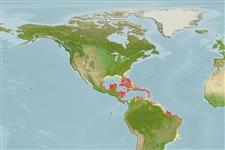>
Blenniiformes (Blennies) >
Blenniidae (Combtooth blennies) > Salariinae
Etymology: Ophioblennius: Greek, ophis = serpent + Greek, blennios = mucus (Ref. 45335).
Eponymy: Dr Charles Freeman Williams McClure (1865–1955) was an American anatomist and embryologist. [...] (Ref. 128868), visit book page.
Environment: milieu / climate zone / depth range / distribution range
Ecología
marino asociado a arrecife. Tropical
Western Central Atlantic: North Carolina, Florida, Caribbean (Bermuda population may be distinct species).
Tamaño / Peso / Age
Maturity: Lm ? range ? - ? cm
Max length : 12.2 cm TL macho / no sexado; (Ref. 26340)
Espinas dorsales (total) : 12; Radios blandos dorsales (total) : 19 - 21; Espinas anales: 2; Radios blandos anales: 20 - 21; Vértebra: 33. Lateral line consists of 2 disconnected, elongate portions where the anterior portion overlaps with the anterior end of the ventral portion (Ref. 43469).
Adults inhabit shallow, clear waters with coral or rock bottoms (Ref. 5521). Territorial (Ref. 9710). Oviparous. Eggs are demersal and adhesive (Ref. 205), and are attached to the substrate via a filamentous, adhesive pad or pedestal (Ref. 94114). Larvae are planktonic, often found in shallow, coastal waters (Ref. 94114).
Life cycle and mating behavior
Madurez | Reproducción | Puesta | Huevos | Fecundidad | Larva
Oviparous, distinct pairing (Ref. 205).
Springer, V.G., 1962. A review of the blenniid fishes of the genus Ophioblennius Gill. Copeia 1962(2):426-433. (Ref. 9861)
IUCN Red List Status (Ref. 130435: Version 2024-2)
Threat to humans
Harmless
Human uses
Pesquerías: sin interés; Acuario: Comercial
Herramientas
Special reports
Download XML
Fuentes de Internet
Estimates based on models
Preferred temperature (Ref.
123201): 26.2 - 28.2, mean 27.4 °C (based on 644 cells).
Phylogenetic diversity index (Ref.
82804): PD
50 = 0.5312 [Uniqueness, from 0.5 = low to 2.0 = high].
Bayesian length-weight: a=0.01122 (0.00514 - 0.02450), b=3.04 (2.87 - 3.21), in cm total length, based on all LWR estimates for this body shape (Ref.
93245).
Nivel trófico (Ref.
69278): 2.5 ±0.1 se; based on size and trophs of closest relatives
Resiliencia (Ref.
120179): Alto, población duplicada en un tiempo mínimo inferior a 15 meses (Preliminary K or Fecundity.).
Fishing Vulnerability (Ref.
59153): Low vulnerability (10 of 100).
Nutrients (Ref.
124155): Calcium = 115 [61, 188] mg/100g; Iron = 0.847 [0.518, 1.364] mg/100g; Protein = 18.3 [17.2, 19.4] %; Omega3 = 0.136 [0.086, 0.219] g/100g; Selenium = 25.8 [14.8, 49.0] μg/100g; VitaminA = 107 [31, 353] μg/100g; Zinc = 2.32 [1.60, 3.25] mg/100g (wet weight);
